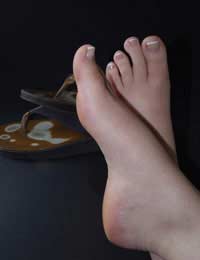Sesamoiditis

Bones that are not connected to other bones and are simply attached to tendons are called sesamoids. They act as a supportive mechanism to the tendons and muscles allowing them to work smoothly and aid weight transfer.
They are found in many areas of the anatomy, including the forefoot where they help with weight transfer and weight bearing and help to assist fine movements like lifting the big toe.
What Is Sesamoiditis?
Sesamoiditis is a common complaint of the foot, and occurs when the tendons surrounding the sesamoids become irritated and inflamed. This is common in young active people and sportspeople, especially dancers.It may also be more likely to develop in those who have high foot arches as this forces increased pressure on to the ball of the foot, and may aggravate the sesamoid bone, causing the tendons to become irritated.
Those who suddenly increase the amount of physical activity may also suffer from this condition, as the joint will not be used to excessive pressure of sudden onset. Activities should be built up gradually with sufficient warm-up and warm down time when necessary.
Signs and Symptoms
As with any inflammation, the first sign of this condition is often pain. The pain is normally felt under the ball of the foot, in particular around the joint of the big toe. It typically develops slowly over time, increasing in severity or can be instant, though this is more likely if the actual sesamoid bone has fractured. The affected area may swell but rarely appears red or bruised.Treatment Options
Many physicians will try and treat the problem conservatively, with initial treatment including the use of pain relief and anti-inflammatory medications. These can be bought from the supermarket or chemists, or if pain is extremely severe, your GP may wish to prescribe drugs that can target this pain.Resting the affected limb will allow for inflammation to subside; try and elevate the foot to above heart level when possible, to aid the drainage of any swelling. Ice packs can also help by both reducing pain and swelling, though care should be taken not to apply ice packs directly to the skin; packs should be wrapped in material such as a tea towel to prevent ice burns occurring.
Wear shoes that are not restrictive but help to support the foot, if necessary temporary use of cushioning pads may help to relieve discomfort. Flat shoes with sufficient width for the toes to be comfortable should be ideal for this purpose.
Sometimes immobilising the joint by strapping the big toe to the rest of the foot, helps to rest the area and allow for quicker healing, this can be done using specially created devices bought from chemists or following advice from your GP, but a simple bandage of an appropriate size may be just as efficient and much cheaper.
If symptoms persist for longer than six weeks, return to your GP for advice which may include the use of steroid injections to help reduce swelling and pain.
In the event that this condition cannot be treated conservatively, surgery may be discussed, with a view to possibly removing the sesamoid bone entirely
.Sesamoiditis is a common condition of the foot, and can normally be treated at home without any need for invasive procedures. Normal first aid practices such as rest, ice and elevation should be sufficient for allowing the area to heal.


Re: Footcare and the Housebound
My dad is housebound due to 5 major strokes. He walks with a walker and wears a foot splint. The splint is old, heavy and no longer…
Re: Supportive Feet Products for Senior Citizens
I have a prescription from Dr. at OHSU, but I need some lab to make the Orthodic insoles for my shoes. I was…
Re: How to Get into Foot Modelling
I am female 32yrs of age.I am from south africa I would like to enter into feet and hands modelling industry .I know and I…
Re: The Benefits of a Paraffin Wax Treatment
Hi! Does it cure sweaty palm and feet too?
Re: I have Sharp Pains in My Foot, What could it be?
Recently I have been experiencing a stabbing pain in my left foot,its on the bottom at the back. When I…
Re: Fungal Infections of the Foot and Toenail
I have a constant problem with intense itching on my feet which erupts daily, especially when my feet get warm…
Re: Cosmetic Foot Surgery
I have extremely sweaty feet and it seems to be getting worse. I have perspirex, but it doesnt help. Please help, I don't know what to do…
Re: The Benefits of Foot Massage for Children
One day I came home and my wife said our younger son was having trouble concentrating on his homework. I asked…
Re: Cavus Feet: Symptoms, Causes and Treatments
@sue - I am sorry to hear this. As suggested in the article, arch supports or orthotic devices may be used to…
Re: Cavus Feet: Symptoms, Causes and Treatments
My daughter has cavus feet and has had surgery a few times already. Her surgeon has dismissed her and she is…